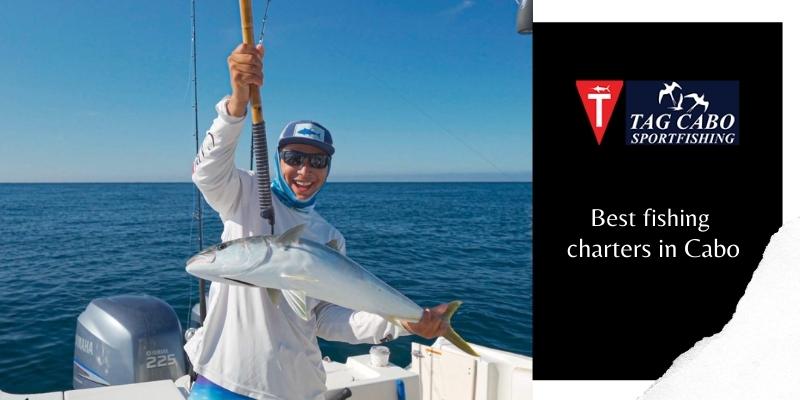A deep-sea angling charter adventure is one of the best ways to enjoy the excitement of the open ocean and the incredible wildlife that inhabits it. Several of these deep-sea species are simply too far away to be seen from the coast. In such cases, you can opt for the best fishing charters in Cabo to access these deep waters.
A deep-sea angling charter excursion allows you to pit your reel against many of the ocean’s most ferocious predators while being accompanied by a professional crew. You’ll get to witness how it’s done & develop an interest in deep-sea fishing as a result.
We’ve put up a list of things you may plan on a chartered deep-sea angling excursion to satisfy your desire for the open sea. Much of it will be determined by what you’re seeking. Don’t forget to allow a place in your thoughts for amazing natural wonders with Cabo San Lucas fishing charters.
5 Pieces of Must-Have Safety Gear for Your Fishing Charter
1. Life jackets &wearable personal flotation devices (PFDs)
A PFD (Type I, II, or III) that is easily accessible and worn must be present for each person on board. A PFD is also required if you’re pulling a skier or just have a wake-surfers behind the boat. Kids below the age of 12 should always take extra precautions when they are on a moving charter. They should always wear a life jacket. Similarly, anyone driving a personal watercraft (PWC) should always wear a life jacket.
In the event of an emergency, the very first thing you need to do is make sure that all travelers onboard put on their life jackets right away. If you want to be proactive, you may propose that everyone onboard put them on right there at the dock before departure. Your pet should also wear a lifejacket, even if it isn’t needed.
This is taken care of when you are on board the Cabo fishing charters.
2. Flotation devices that can be thrown
In addition to your life jackets, you’ll need to have at least one Type IV floating device to throw to someone in the water if they get into trouble. It can be a ring buoy, a cushion, or any other device. Some of this equipment may include a line that can be used to draw someone nearer to the boat & eventually out from the water.
The best fishing charters in Cabo will always have a flotation device for your safety.
3. Fire extinguishers
Extinguishers are available in a wide range of types and categories. However, to keep things simple, boats under 26 ft (including PWCs) likely require 1 B-1 type extinguisher. Boats 26 to just below 40 feet require 2 B-1 types or 1 B-2 type. Discuss how to use an extinguisher with your family & guests: Pull the pin out, squeeze the handle, and aim at the flames’ base.
4. Devices for visual signaling
Visual distress signs exist in several packages, and the size of the vessel & even the state where you can go boating have various regulations. On boats under 16 feet, flares or nighttime signals are essential. Boats with a length of more than 16 feet must have visible signals for day & night use.
Orange or white smoke, as well as aerial light flares, are types of pyrotechnic devices that would qualify. Many flares can be fired without the need for a flare gun, whereas others do. A strobe light is another nighttime gadget, while flags are used during the day. PWCs are not allowed to function between sunset and sunrise. Thus, nighttime equipment isn’t necessary.
5. Devices that emit audible signals
Sounds can summon help at any moment of day or night. They are incredibly useful in fog. Horns and whistles are regarded as sound-generating devices for all boats, whether portable or stationary. In situations of poor visibility, such as fog, larger vessels (above 39 ft) should also include a bell that can be sounded at frequent intervals.
12 Pieces of Boat Safety Equipment You Should Have
Some of these items may be necessary or just recommended regardless of the type of watercraft that you do & where you do it. In any case, you can fit most of these on even the tiniest of boats.
- First aid kit for scrapes, seasickness, cuts, or any other emergencies
- To call for assistance, carry your cell phone.
- To dewater & stay afloat, make sure to keep a bailing device or a bucket.
- If the motor fails, use oars or paddles.
- VHF radio to seek help
- While you wait for assistance, anchor along with a line to keep your boat in place.
- Heavy-duty flashlight
- Snorkel mask to look under the boat and see what’s going on.
- A knife to cut the line around a jammed propeller
- Down flag for skier or diver
- Your boat must have working running lights
- On a lake, weather can change quickly, and that’s why you need to get weather updates
Conclusion:
Whether you’re fishing, wakeboarding, day cruising, diving, skiing, or overnighting on your boat, don’t forget to bring the necessary safety equipment. If you have it on board, make sure it’s in proper working order by inspecting it regularly. This article should address some of your queries concerning fishing charter safety equipment.
Are you looking for a safe fishing excursion in Cabo? Tag Cabo Sport Fishing can enhance your experience whether you are in Cabo for whale viewing or just want to try your luck at sport fishing. Tag Cabo Sportfishing not only assists you in locating the ideal fishing site but also in having your fishing experience even better. In case you need any help or information, please mail us at tagsportfishing@gmail.com

